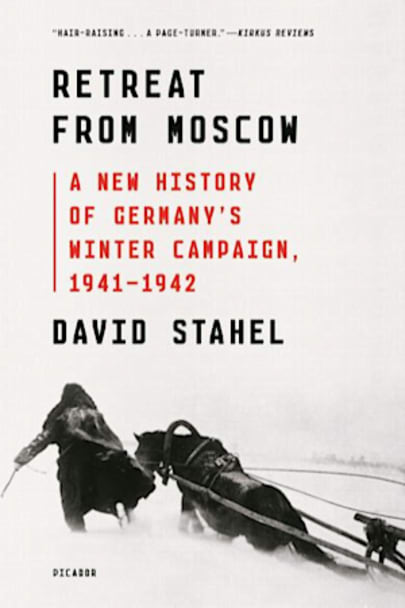A gripping and authoritative revisionist account of the German Winter Campaign of 1941-1942 Germany’s winter campaign of 1941-1942 is commonly seen as its first defeat. In Retreat from Moscow, a bold, gripping account of one of the seminal moments of World War II, David Stahel argues that instead it was its first strategic success in the East. The Soviet counteroffensive was in fact a Pyrrhic … was in fact a Pyrrhic victory. Despite being pushed back from Moscow, the Wehrmacht lost far fewer men, frustrated its enemy’s strategy, and emerged in the spring unbroken and poised to recapture the initiative.
Hitler’s strategic plan called for holding important Russian industrial cities, and the German army succeeded. The Soviets as of January 1942 aimed for nothing less than the destruction of Army Group Center, yet not a single German unit was ever destroyed. Lacking the professionalism, training, and experience of the Wehrmacht, the Red Army’s offensive attempting to break German lines in countless head-on assaults led to far more tactical defeats than victories.
Using accounts from journals, memoirs, and wartime correspondence, Stahel takes us directly into the Wolf’s Lair to reveal a German command at war with itself as generals on the ground fought to maintain order and save their troops in the face of Hitler’s capricious, increasingly irrational directives. Excerpts from soldiers’ diaries and letters home paint a rich portrait of life and death on the front, where the men of the Ostheer battled frostbite nearly as deadly as Soviet artillery. With this latest installment of his pathbreaking series on the Eastern Front, David Stahel completes a military history of the highest order.
more



This work is massive in scope, involving vast geographic areas and millions of men. It does not discuss the retreat from Moscow at the individual soldier’s level, but at the corps and army level. We are treated to the workings of the very highest-ranking German generals on the Eastern Front. David Stahel, the author, is a professional historian, teaching both at the University of New South Wales and the Australian Defence Force Academy. This is the latest in a number of books he has written about the German Army on the Eastern Front during World ll. His purpose in writing this book is to show that the German retreat from Moscow was a victory “tactically, operationally, and even strategically”, and not a defeat as is often claimed by other historians.
Retreat From Moscow is also a very detailed telling of the German high command’s three-way battle with the Communists, Hitler, and the Russian winter. It is packed with historical facts of which most people are generally unaware. Which German general on the Eastern Front could mostly be likened to U.S. General Omar Bradley, the “soldier’s general”? Which side’s generals were most afraid to contradict their ruler? What motivated Hitler to give the Halt Order, thus preventing his armies from making orderly and life saving retreats in the face of vastly superior numbers? Why did the Communists throw wave after wave of mass attacks against well-entrenched National Socialist armies? These and many other questions are answered here.
The author’s treatment of the Wehrmacht Generals is uneven. At times it seems as if the author has taken a break from writing and then come back in a different frame of mind. This is particularly true in his treatment of Field Marshal Kluge, the commander of Army Group Center. Stahel shows a particular animus towards General Heinz Guderian, but does not tell the reader why. This may have been developed in one of the author’s earlier works. There is an impression that perhaps things were said in Mr. Stahel’s earlier books that should have been repeated for clarity’s sake in this volume. Stahel blames Guderian for the German army’s failure to be prepared for winter warfare. This hardly seems fair, though, because Guderian was a blitzkrieg general who had no expectation of having to fight winter warfare. The author also appears ambivalent in his attitude toward the opposing forces. He illustrates some of the German’s inexcusable treatment of Russian civilians, but insinuates that reports of Russian brutality toward German prisoners were mere rumors. He never calls the Soviets “Communists”, but usually refers to the Germans as “Nazis.” The writer does show human understanding for the suffering of the Wermacht troops in the field, but very little for the generals. One might expect a professional historian to show a bit more detachment than our author does, but there may be a good explanation for this. He is an academic, after all, writing in an environment not known for its tolerance of deviation from expected viewpoints.
On the whole, this is a very good book, especially for professional historians and serious students of history. For casual readers, it could be one or two hundred pages shorter. It is to be heartily recommended, but not in its e-book version. Professor Stahel makes generous use of maps and footnotes, which can be extremely difficult to utilize in an e-book edition.
,
Edward J. Ward